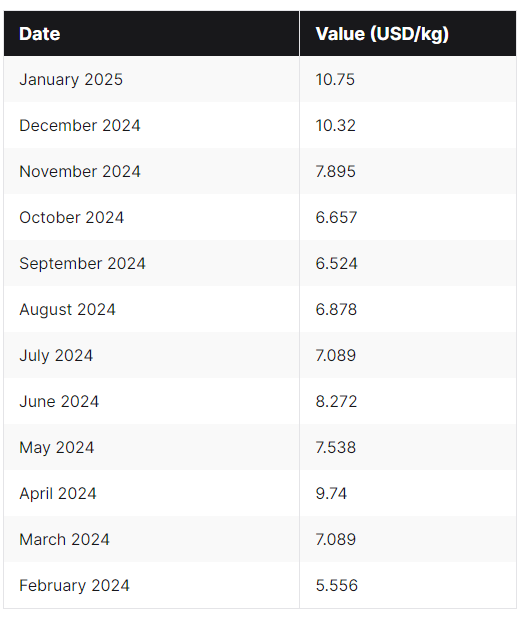
Cocoa prices hit record high: What does this mean for industry?
By Donna Eastlake
06-Feb-2025 Last updated on 06-Feb-2025 at 15:09 GMT
The cost of cocoa has reached a record high, and the price keeps climbing. How is industry reacting and what does this mean for the future of this highly sought after commodity?
The price of cocoa hit a record high in December, reaching$10.32 per kilogram. But rather than levelling out, or even declining, the price has continued to rise, reaching $10.75 per kilogram on 31 January (YCharts).
Cocoa price fluctuations over the past 12months(source: YCharts)

This sharp climb has sent shockwaves through the food and beverage industry, sparking fears that prices will spiral out of control.
“This surge was the largest seen in over six decades,” says Nidhi Jain, commodity specialist at WNS Procurement.
So, what’s causing the rise and what does this mean for the food and beverage industry?
Why are cocoa prices rising?
This sharp increase in cocoa prices has been driven by concerns over poor weather conditions in West Africa, a major growing region and primary supplier to the EuropeanUnion (EU).
According to the World Bank, global cocoa production is estimated to have declined by 14% in the 2023-24 season, falling to 4.2mmt, from 4.9mmt in 2022-23.
“This decline is largely due to reduced output in Côte d’Ivoire and Ghana, which together produce nearly 60% of the world’s cocoa,” says John Baffes, senior agriculture economist for Development Economics Prospects Group.”
This was exacerbated by strong seasonal demand, as consumers stocked-up on cakes and chocolates for the festive season, leading to a global deficit.
“The International Cocoa Organisation (lCCO) reported a production deficit of 478,000mmt for the 2023-24 season, with end-of-season stocks projected at 1.3mmt, the lowest levels in 46 years,” says WNS Procurement’s Jain.
However, there is some potentially positive news, withsigns of a possible recovery.
“Supply conditions are expected to improve in the 2024-25 season, particularly in Cóte d’lvoire, where favourable weather across key growing regions could boost production by up to 17%,” says Development Economics Prospects Group’s Baffes.
This, says Baffes, should lead to prices easing by around 13% in 2025 and a further 2% in 2026 as additional supplies enter the market.
However, he’s quick to note that the potential return of adverse weather in West Africa poses a significant risk to supply and prices.
And while there is hope on the horizon, prices willremain elevated in the short term.
“Costs are expected to remain elevated due to theongoing supply constraints,” says WNS Procurement’s Jain.
Another threat to cocoa
In addition to poor weather conditions, in growing regions, cocoa growers are facing another serious threat-Cacao swollen shoot virus (CsSV).
“The spread of the cocoa swollen shoot virus disease in West Africa has negatively impacted cocoa production,” says WNS Procurement’s Jain.”Global cocoa supplies have therefore been significantly reduced.”
CSSV is a plant pathogenic virus, which primarily infects cacao trees.lt decreases cacao yield, within the first year of infection, and then typically kills the tree within a few years.
Symptoms of CSSv vary by strain, but leaf discolouration, stem/root swelling, and die-back generally occur. The virus is transmitted from tree to tree by mealybug vectors.
What does this mean for food andbeverage manufacturers?
The concern felt by food and beverage manufacturers is clear, with major manufacturers already adjusting profit projections.
Many other manufacturers, are exploring other avenues, including changing pack sizes, increasing prices, modifying formulations by using alternative ingredients to cocoa and reducing cocoa content.
But while larger manufacturers are able to adapt to absorb these costs, this could spell disaster for smaller manufacturers.
“Our profit margins are small,” says Helen Jones, head chocolatier at independent producer, Zara’s Chocolates.
And so, like some larger manufacturers, they have been forced to increase their prices in order to survive.
“We put a little note in the shop to explain why the prices were increasing, and thankfully people were really good about it,” says Jones.
But what more can manufacturers, large and small, do to weather the current cocoa price storm?
“To mitigate the impact of these supply issues, procurement teams should continuously identify and monitor risks that can impact supply chains in addition to assessing alternative suppliers from different regions,” says WNS Procurement’s Jain. “By doing so, they can reduce their company’s dependence on a single provider or location, especially if they are buying a commodity from an area faced with challenges in their production pipeline.”
Additionally, says Jain, manufacturers should map their dependence on suppliers.
“By thoroughly evaluating their supplier exposure across geographies, organisations can ensure that any decrease in production doesn’t severely affect their operations.”






